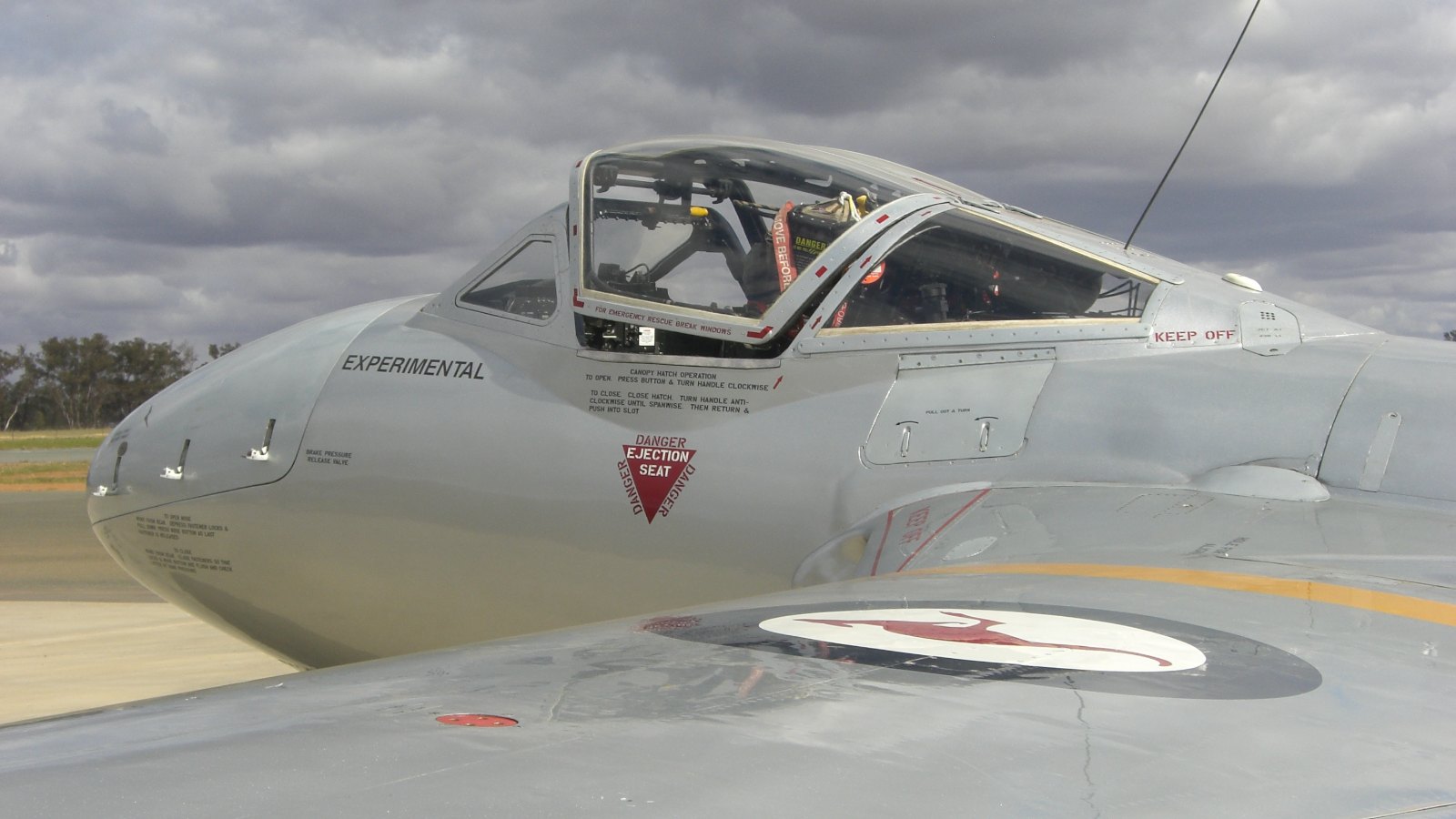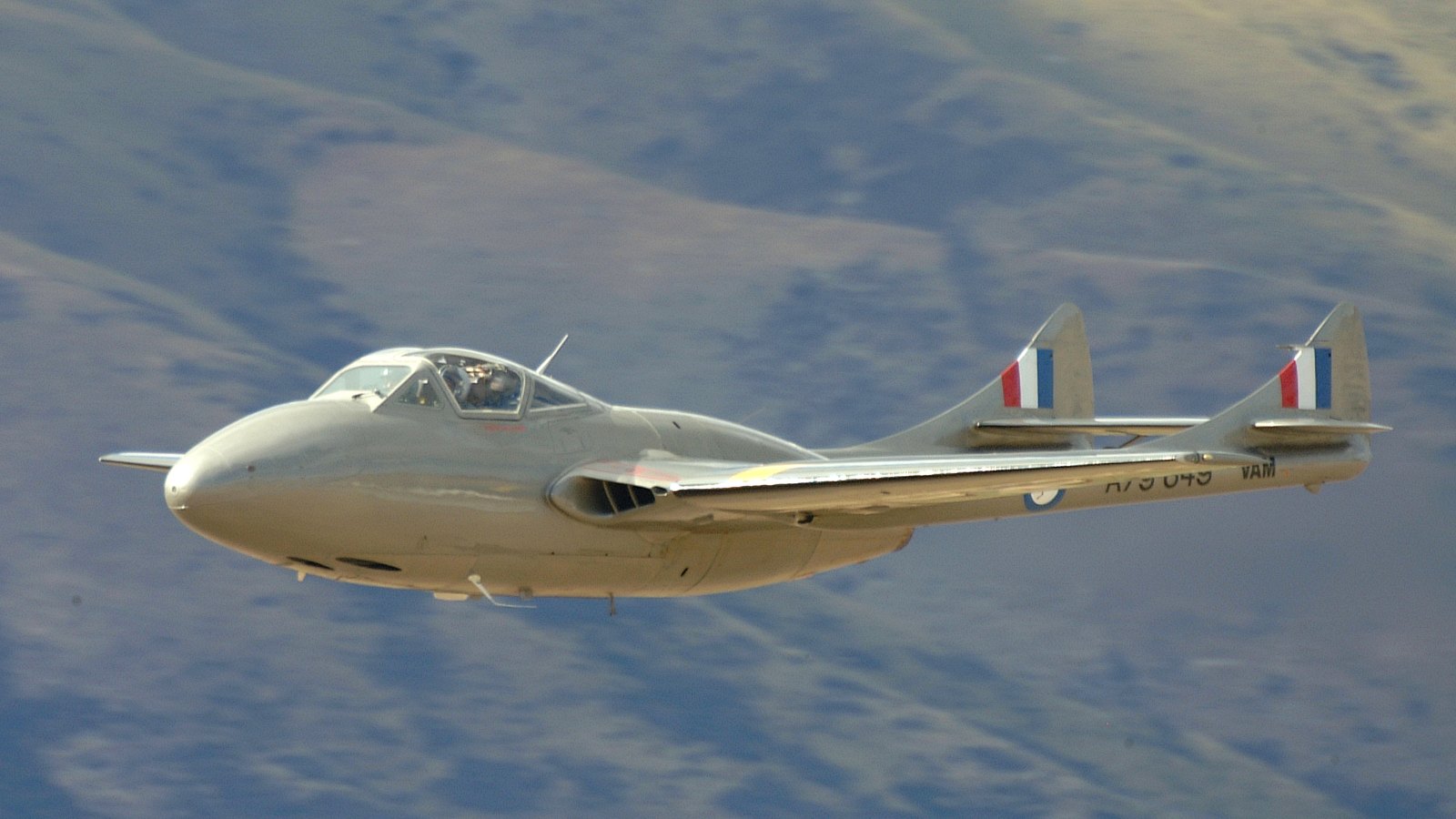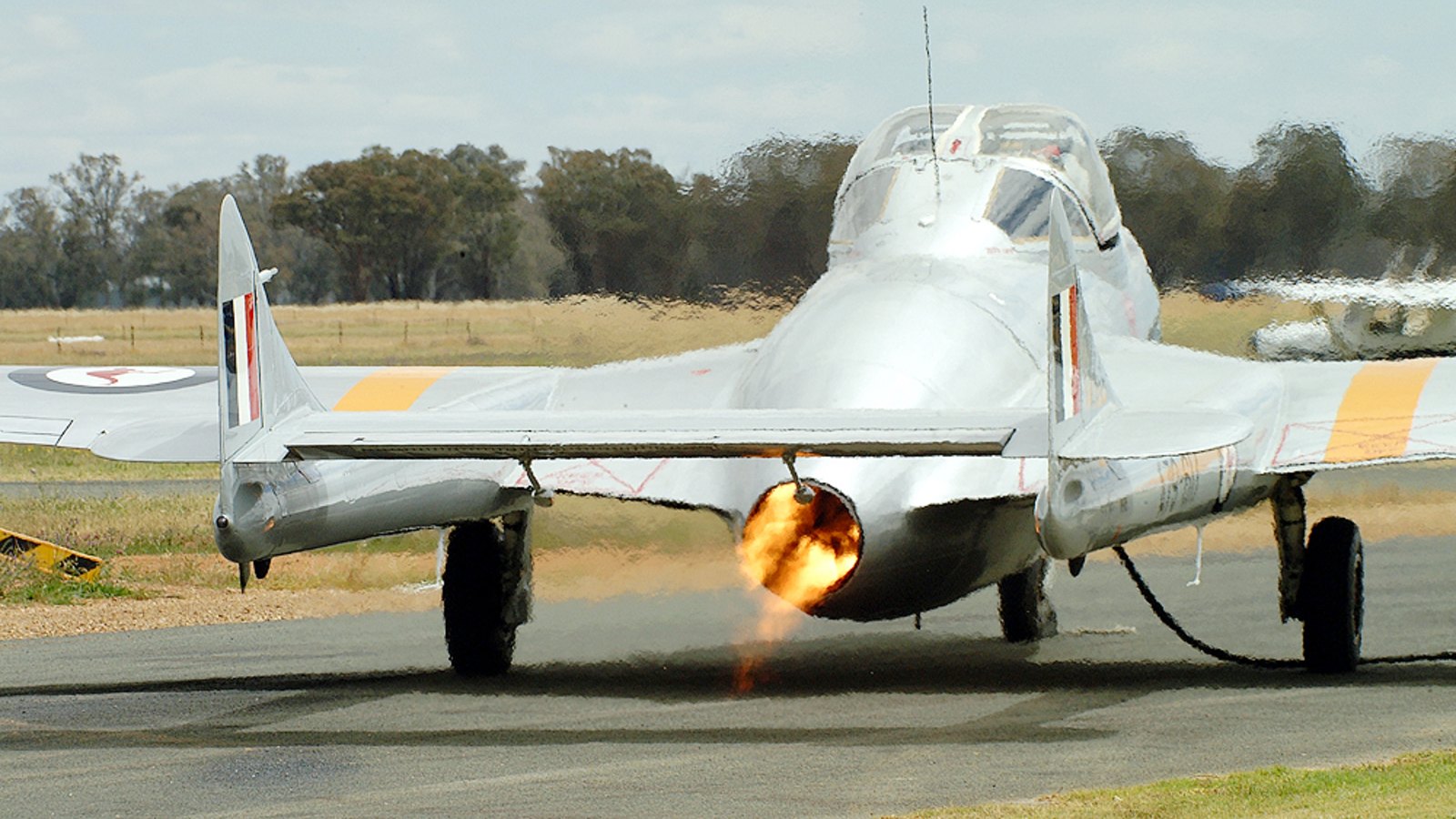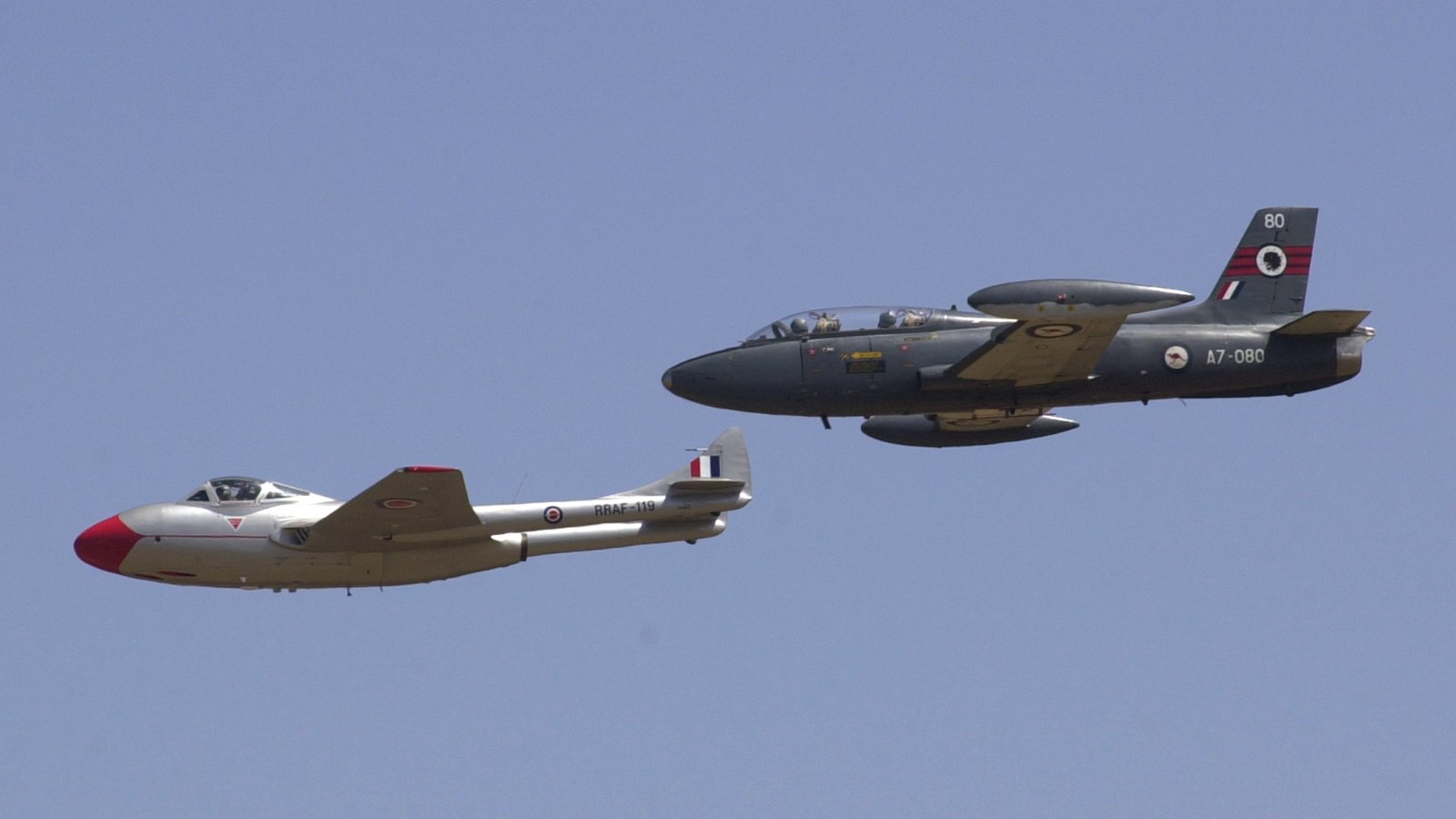The de Havilland DH-115 Vampire T.35 joined the ranks of the Royal Australian Air Force in 1946, three years after it flew for the first time for the British RAF. Initial development of the single-seat fighter jet was commissioned by the RAF during WWII, though the jet arrived too late to ever see combat.
Powered by a single de Havilland Goblin engine, the turbojet was considered experimental in its time, due to its use of just one, powerful engine. The plane’s pod-shaped design was constructed out of a mix of wood and metals, and was initially dubbed the “Spider Crab”. It measures a length of just over 9 metres, with a wingspan of 11.5 metres.
This content is available exclusively to Australian Aviation members.
Subscribe to Australian Aviation for unlimited access to exclusive content and past magazines.Comments (15)
Comments are closed.
You don't have credit card details available. You will be redirected to update payment method page. Click OK to continue.






















Tony Griggs
says:I once witnessed the Vampire at the Mangalore Airshow taxi out to undertake a flying display. Arrogantly, I thought to myself, this will likely be a fizzer of a display. When it flew past after take off, I heard the sweetest sounding engine of my life…..I will never forget it. The Rolls Royce Goblin. How wrong could I have been!
Eric Chandler
says:I remember these flying low across our farm paddocks during training in the 60s in WA when I was a kid. The brightly coloured red on the tail fins and the noise as they came rushing past us.
Kim
says:Was great to see these Mirages doing spectacular barrel rolls over the Woomera Village, in 1969 whilst I was working there.
Mike Auret
says:Mirages in their various iterations were extensively used by the South African and Israeli Airforces. The Israelis ‘won’ their air battle against Egypt, who were using a mix of mainly Russian aircraft, using the Mirage 111, and the earlier model. They destroyed the Egyptian Air Force is days!
South Africa used these, already old and near obsolescent, aircraft in the 30 year Border Wars, along with the lore advanced Mirage F1, culminating in the late 1980’s. This was against the might of the Russian, East German and Cuban cabal, using MIG 21 and 23 model.
Bill MacCubbin
says:The FA-18 was in service for considerably longer than the Mirage.
Gregory Jarosch
says:Why wasn’t a squadron or two of Mirages kept in flying condition and as display models for more aero and airport museums
and technology museums around Australia?
Gordon Mackinlay
says:I put this item up yesterday morning but it not published, so I repeat.
I whilst employed as a UN Field Officer flew frequently in a former RAAF Caribou in Liberia (West Africa) 2013, it had been totally rebuilt in Malta to same standard as proposed for the RAAF in the early 1990’s. Turbo-prop engines, new avionics and completely rewired, all panels, flooring etc had been placed on jigs and refurbished.
The various European pilots and ground crew, all younger than the Caribous that flown there. They considering that it vastly superior to the G-222 which had been rebuilt to the same standard as a C27-J (a former Libyan G.222 aircraft that had been in storage for many years, and had very low hours on the original air frame.)
Two of the pilots (a Greek and a Italian) had flown the C-27J in their own air forces, and considered the Caribou a superior military tactical transpor. One of the company’s executives stated that it had been considerably cheaper to convert (after buying) the Caribou than to buy a new Airbus C-295, and its operating costs some 35% less than the converted C-27.
And the great thing about their Caribou, it was really quiet and it did not vibrate. With the late model Pilatus PC-6 Porter fleet, the company could fly into any location in Liberia and Sierra Leone.
Alan Hume
says:The article slavishly states “In December 2020, after a distinguished career, the first F/A-18A was officially handed over to the Australian War Memorial … Minister for Defence Industry Melissa Price called its placing there a “fitting tribute” to the aircraft.” Well, of course she would, she’s a politician after all! And one from the same political party as the former CEO of the AWM, Brendan Nelson. This Government is turning the AWM in Canberra from a Memorial to our fallen and the futility of war itself, into a museum glorifying the equipment of war (without referencing the collateral damage they cause), at an exorbitant cost of $500 million of taxpayers’ money against every sage and objective advice to the contrary.
Gordon Mackinlay
says:I put the following up twice before, but for some ‘reason’ not displayed.
“I put this item up yesterday morning but it not published, so I repeat.
I whilst employed as a UN Field Officer flew frequently in a former RAAF Caribou in Liberia (West Africa) 2013, it had been totally rebuilt in Malta to the same standard as proposed for the RAAF in the early 1990’s. Turbo-prop engines, new avionics and completely rewired, all panels, flooring etc had been placed on jigs and refurbished.
The various European pilots and ground crew, all younger than the Caribous that flown there. They considering that it vastly superior to the G-222 which had been rebuilt to the same standard as a C27-J (a former Libyan G.222 aircraft that had been in storage for many years, and had very low hours on the original air frame.)
Two of the pilots (a Greek and a Italian) had flown the C-27J in their own air forces, and considered the Caribou a superior military tactical transport. One of the company’s executives stated that it had been considerably cheaper to convert (after buying) the Caribou than to buy a new Airbus C-295, and its operating costs some 35% less than the converted C-27.
And the great thing about their Caribou, it was really quiet and it did not vibrate. With the late model Pilatus PC-6 Porter fleet, the company could fly into any location in Liberia and Sierra Leone.”
Peter Ricketts
says:Hawker de Havilland at Bankstown also built 100 two seat Vampire trainers.
Ray
says:You might want to check your images again, no.3 is a USN F/A-18E and no.6 is a RAAF F/A-18F
Gordon Smith
says:Yes a very amazing aircraft! So we started with the C130As what iteration of Hercules model are we up to now in 2021?
Gordon Smith
says:Correction to the article on the RAAF Vampire aircraft, I think that you will find that the navy’s carrier based version was not called a Sea Vampire…..but a Sea Venom.
David B
says:https://www.navy.gov.au/aircraft/de-havilland-sea-vampire-mk-t22-t34
David B
says:On the Vampire article, perhaps you mean David Lowy not ‘Lowry’